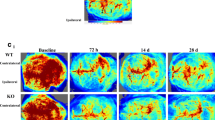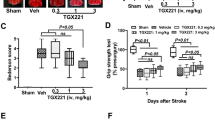Abstract
Arteriogenesis involves the rapid proliferation of preexisting arterioles to fully functional arteries as a compensatory mechanism to overcome circulatory deficits. Stimulation of arteriogenesis has therefore been considered a treatment concept in arterial occlusive disease. Here, we investigated the impact of inhibition of protein tyrosine phosphatases (PTPs) on cerebral arteriogenesis in rats. Arteriogenesis was induced by occlusion of one carotid and both vertebral arteries (three-vessel occlusion (3-VO)). Collateral growth and functional vessel perfusion was assessed 3–35 days following 3-VO. Furthermore, animals underwent 3-VO surgery and were treated with the pan-PTP inhibitor BMOV, the SHP-1 inhibitor sodium stibogluconate (SSG), or the PTP1B inhibitor AS279. Cerebral vessel diameters and cerebrovascular reserve capacity (CVRC) were determined, together with immunohistochemistry analyses and proximity ligation assays (PLA) for determination of tissue proliferation and phosphorylation patterns after 7 days. The most significant changes in vessel diameter increase were present in the ipsilateral posterior cerebral artery (PCA), with proliferative markers (PCNA) being time-dependently increased. The CVRC was lost in the early phase after 3-VO and partially recovered after 21 days. PTP inhibition resulted in a significant increase in the ipsilateral PCA diameter in BMOV-treated animals and rats subjected to PTP1B inhibition. Furthermore, CVRC was significantly elevated in AS279-treated rats compared to control animals, along with hyperphosphorylation of the platelet-derived growth factor-β receptor in the vascular wall in vivo. In summary, our data indicate PTPs as hitherto unrecognized negative regulators in cerebral arteriogenesis. Further, PTP inhibition leading to enhanced collateral growth and blood perfusion suggests PTPs as novel targets in anti-ischemic treatment.
Key Messages
-
PTPs exhibit negative regulatory function in cerebral collateral growth in rats.
-
Inhibition of pan-PTP/PTP1B increases vessel PDGF-β receptor phosphorylation.
-
PTP1B inhibition enhances arteriogenesis and cerebrovascular reserve capacity.





Similar content being viewed by others
References
Cai W, Schaper W (2008) Mechanisms of arteriogenesis. Acta Biochim Biophys Sin (Shanghai) 40:681–692
Fung E, Helisch A (2012) Macrophages in collateral arteriogenesis. Front Physiol 3:353
Meisner JK, Price RJ (2010) Spatial and temporal coordination of bone marrow-derived cell activity during arteriogenesis: regulation of the endogenous response and therapeutic implications. Microcirculation 17:583–599
Dromparis P, Sutendra G, Paulin R, Proctor S, Michelakis ED, McMurtry MS (2014) Pioglitazone inhibits HIF-1 alpha-dependent angiogenesis in rats by paracrine and direct effects on endothelial cells. J Mol Med (Berl)
Waltenberger J (2007) Stress testing at the cellular and molecular level to unravel cellular dysfunction and growth factor signal transduction defects: what molecular cell biology can learn from cardiology. Thromb Haemost 98:975–979
Toyota E, Warltier DC, Brock T, Ritman E, Kolz C, O'Malley P, Rocic P, Focardi M, Chilian WM (2005) Vascular endothelial growth factor is required for coronary collateral growth in the rat. Circulation 112:2108–2113
Bohmer F, Szedlacsek S, Tabernero L, Ostman A, den Hertog J (2013) Protein tyrosine phosphatase structure-function relationships in regulation and pathogenesis. FEBS J 280:413–431
Kappert K, Peters KG, Bohmer FD, Ostman A (2005) Tyrosine phosphatases in vessel wall signaling. Cardiovasc Res 65:587–598
Nakayama K, Takahashi K, Shultz LD, Miyakawa K, Tomita K (1997) Abnormal development and differentiation of macrophages and dendritic cells in viable motheaten mutant mice deficient in haematopoietic cell phosphatase. Int J Exp Pathol 78:245–257
Buschmann IR, Busch HJ, Mies G, Hossmann KA (2003) Therapeutic induction of arteriogenesis in hypoperfused rat brain via granulocyte-macrophage colony-stimulating factor. Circulation 108:610–615
Chu LY, Ramakrishnan DP, Silverstein RL (2013) Thrombospondin-1 modulates VEGF signaling via CD36 by recruiting SHP-1 to VEGFR2 complex in microvascular endothelial cells. Blood
Yu Z, Su L, Hoglinger O, Jaramillo ML, Banville D, Shen SH (1998) SHP-1 associates with both platelet-derived growth factor receptor and the p85 subunit of phosphatidylinositol 3-kinase. J Biol Chem 273:3687–3694
Kim CH, Qu CK, Hangoc G, Cooper S, Anzai N, Feng GS, Broxmeyer HE (1999) Abnormal chemokine-induced responses of immature and mature hematopoietic cells from motheaten mice implicate the protein tyrosine phosphatase SHP-1 in chemokine responses. J Exp Med 190:681–690
Barr AJ (2010) Protein tyrosine phosphatases as drug targets: strategies and challenges of inhibitor development. Futur Med Chem 2:1563–1576
Chang Y, Ceacareanu B, Zhuang D, Zhang C, Pu Q, Ceacareanu AC, Hassid A (2006) Counter-regulatory function of protein tyrosine phosphatase 1B in platelet-derived growth factor- or fibroblast growth factor-induced motility and proliferation of cultured smooth muscle cells and in neointima formation. Arterioscler Thromb Vasc Biol 26:501–507
Nakamura Y, Patrushev N, Inomata H, Mehta D, Urao N, Kim HW, Razvi M, Kini V, Mahadev K, Goldstein BJ et al (2008) Role of protein tyrosine phosphatase 1B in vascular endothelial growth factor signaling and cell-cell adhesions in endothelial cells. Circ Res 102:1182–1191
Kruger J, Trappiel M, Dagnell M, Stawowy P, Meyborg H, Bohm C, Bhanot S, Ostman A, Kintscher U, Kappert K (2013) Targeting density-enhanced phosphatase-1 (DEP-1) with antisense oligonucleotides improves the metabolic phenotype in high-fat diet-fed mice. Cell Commun Signal CCS 11:49
Ostergaard L, Jespersen SN, Mouridsen K, Mikkelsen IK, Jonsdottir KY, Tietze A, Blicher JU, Aamand R, Hjort N, Iversen NK et al (2013) The role of the cerebral capillaries in acute ischemic stroke: the extended penumbra model. J Cereb Blood Flow Metab 33:635–648
Scior T, Mack HG, Garcia JA, Koch W (2009) Antidiabetic Bis-Maltolato-OxoVanadium(IV): conversion of inactive trans- to bioactive cis-BMOV for possible binding to target PTP-1B. Drug Des Devel Ther 2:221–231
Pathak MK, Yi T (2001) Sodium stibogluconate is a potent inhibitor of protein tyrosine phosphatases and augments cytokine responses in hemopoietic cell lines. J Immunol 167:3391–3397
Gomez E, Vercauteren M, Kurtz B, Ouvrard-Pascaud A, Mulder P, Henry JP, Besnier M, Waget A, Hooft Van Huijsduijnen R, Tremblay ML et al (2012) Reduction of heart failure by pharmacological inhibition or gene deletion of protein tyrosine phosphatase 1B. J Mol Cell Cardiol 52:1257–1264
Vercauteren M, Remy E, Devaux C, Dautreaux B, Henry JP, Bauer F, Mulder P, Hooft van Huijsduijnen R, Bombrun A, Thuillez C et al (2006) Improvement of peripheral endothelial dysfunction by protein tyrosine phosphatase inhibitors in heart failure. Circulation 114:2498–2507
Claesson-Welsh L, Welsh M (2013) VEGFA and tumour angiogenesis. J Intern Med 273:114–127
Chen JX, Tuo Q, Liao DF, Zeng H (2012) Inhibition of protein tyrosine phosphatase improves angiogenesis via enhancing Ang-1/Tie-2 signaling in diabetes. Exp Diabetes Res 2012:836759
Winter CL, Lange JS, Davis MG, Gerwe GS, Downs TR, Peters KG, Kasibhatla B (2005) A nonspecific phosphotyrosine phosphatase inhibitor, bis(maltolato)oxovanadium(IV), improves glucose tolerance and prevents diabetes in Zucker diabetic fatty rats. Exp Biol Med (Maywood) 230:207–216
Carr AN, Davis MG, Eby-Wilkens E, Howard BW, Towne BA, Dufresne TE, Peters KG (2004) Tyrosine phosphatase inhibition augments collateral blood flow in a rat model of peripheral vascular disease. Am J Physiol Heart Circ Physiol 287:H268–H276
Peters KG, Davis MG, Howard BW, Pokross M, Rastogi V, Diven C, Greis KD, Eby-Wilkens E, Maier M, Evdokimov A et al (2003) Mechanism of insulin sensitization by BMOV (bis maltolato oxo vanadium); unliganded vanadium (VO4) as the active component. J Inorg Biochem 96:321–330
Dance M, Montagner A, Salles JP, Yart A, Raynal P (2008) The molecular functions of Shp2 in the Ras/Mitogen-activated protein kinase (ERK1/2) pathway. Cell Signal 20:453–459
Hackbusch D, Dulsner A, Gatzke N, Kruger J, Hillmeister P, Nagorka S, Blaschke F, Ritter Z, Thone-Reineke C, Bohmer FD et al (2013) Knockout of density-enhanced phosphatase-1 impairs cerebrovascular reserve capacity in an arteriogenesis model in mice. Biomed Res Int 2013:802149
Kappert K, Paulsson J, Sparwel J, Leppanen O, Hellberg C, Ostman A, Micke P (2007) Dynamic changes in the expression of DEP-1 and other PDGF receptor-antagonizing PTPs during onset and termination of neointima formation. FASEB J 21:523–534
ten Freyhaus H, Dagnell M, Leuchs M, Vantler M, Berghausen EM, Caglayan E, Weissmann N, Dahal BK, Schermuly RT, Ostman A et al (2011) Hypoxia enhances platelet-derived growth factor signaling in the pulmonary vasculature by down-regulation of protein tyrosine phosphatases. Am J Respir Crit Care Med 183:1092–1102
Tallquist M, Kazlauskas A (2004) PDGF signaling in cells and mice. Cytokine Growth Factor Rev 15:205–213
Caglayan E, Vantler M, Leppanen O, Gerhardt F, Mustafov L, Ten Freyhaus H, Kappert K, Odenthal M, Zimmermann WH, Tallquist MD et al (2011) Disruption of platelet-derived growth factor-dependent phosphatidylinositol 3-kinase and phospholipase Cgamma 1 activity abolishes vascular smooth muscle cell proliferation and migration and attenuates neointima formation in vivo. J Am Coll Cardiol 57:2527–2538
Klinghoffer RA, Kazlauskas A (1995) Identification of a putative Syp substrate, the PDGF beta receptor. J Biol Chem 270:22208–22217
Chiong M, Morales P, Torres G, Gutierrez T, Garcia L, Ibacache M, Michea L (2013) Influence of glucose metabolism on vascular smooth muscle cell proliferation. VASA Zeitschrift fur Gefasskrankheiten 42:8–16
Lyons BL, Smith RS, Hurd RE, Hawes NL, Burzenski LM, Nusinowitz S, Hasham MG, Chang B, Shultz LD (2006) Deficiency of SHP-1 protein-tyrosine phosphatase in “viable motheaten” mice results in retinal degeneration. Invest Ophthalmol Vis Sci 47:1201–1209
Sen G, Mandal S, Roy SS, Mukhopadhyay S, Biswas T (2005) Therapeutic use of quercetin in the control of infection and anemia associated with visceral leishmaniasis. Free Radic Biol Med 38:1257–1264
Koch E, Pircher J, Czermak T, Gaitzsch E, Alig S, Mannell H, Niemeyer M, Krotz F, Wornle M (2013) The endothelial tyrosine phosphatase SHP-1 plays an important role for vascular haemostasis in TNF alpha-induced inflammation in vivo. Mediat Inflamm 2013:279781
Acknowledgments
KK was supported by the Deutsche Forschungsgemeinschaft (DFG) (KA1820/4-1), the Charité-University Medicine Berlin, and receives funding from the Marga und Walter Boll-Stiftung (210-04-10). IB was supported by the Deutsche Forschungsgemeinschaft (BU1151/6-1). This work was supported by a grant of the Japanese Society for the Promotions of Science (JSPS) to DH (PE11501). Studies were supported by grants to AÖ from Swedish Research Council.
Disclosure
RH was employed by Merck Serono International S.A., Geneva, Switzerland.
Author information
Authors and Affiliations
Corresponding author
Additional information
Ivo Buschmann, Daniel Hackbusch, and Nora Gatzke contributed equally.
Rights and permissions
About this article
Cite this article
Buschmann, I., Hackbusch, D., Gatzke, N. et al. Inhibition of protein tyrosine phosphatases enhances cerebral collateral growth in rats. J Mol Med 92, 983–994 (2014). https://doi.org/10.1007/s00109-014-1164-z
Received:
Revised:
Accepted:
Published:
Issue Date:
DOI: https://doi.org/10.1007/s00109-014-1164-z




